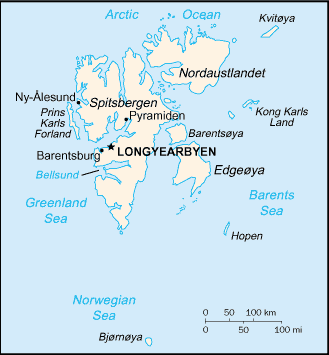|
|
Legend:
 Definition
Definition
 Field Listing
Field Listing
|
Background:
|


First discovered by the Norwegians in the 12th century, the islands served as an international whaling base during the 17th and 18th centuries. Norway's sovereignty was recognized in 1920; five years later it officially took over the territory.
|
|
Location:
|


Northern Europe, islands between the Arctic Ocean, Barents Sea, Greenland Sea, and Norwegian Sea, north of Norway
|
|
Geographic coordinates:
|


78 00 N, 20 00 E
|
|
Map references:
|


Arctic Region
|
|
Area:
|


total: 62,049 sq km
note: includes Spitsbergen and Bjornoya (Bear Island)
water: 0 sq km
land: 62,049 sq km
|
|
Area - comparative:
|


slightly smaller than West Virginia
|
|
Land boundaries:
|


0 km
|
|
Coastline:
|


3,587 km
|
|
Maritime claims:
|


exclusive fishing zone: 200 NM unilaterally claimed by Norway but not recognized by Russia
territorial sea: 4 NM
|
|
Climate:
|


arctic, tempered by warm North Atlantic Current; cool summers, cold winters; North Atlantic Current flows along west and north coasts of Spitsbergen, keeping water open and navigable most of the year
|
|
Terrain:
|


wild, rugged mountains; much of high land ice covered; west coast clear of ice about one-half of the year; fjords along west and north coasts
|
|
Elevation extremes:
|


lowest point: Arctic Ocean 0 m
highest point: Newtontoppen 1,717 m
|
|
Natural resources:
|


coal, copper, iron ore, phosphate, zinc, wildlife, fish
|
|
Land use:
|


arable land: 0%
permanent crops: 0%
other: 100% (no trees, and the only bushes are crowberry and cloudberry) (1998 est.)
|
|
Irrigated land:
|


NA sq km
|
|
Natural hazards:
|


ice floes often block the entrance to Bellsund (a transit point for coal export) on the west coast and occasionally make parts of the northeastern coast inaccessible to maritime traffic
|
|
Environment - current issues:
|


NA
|
|
Geography - note:
|


northernmost part of the Kingdom of Norway; consists of nine main islands; glaciers and snowfields cover 60% of the total area
|
|
Economy - overview:
|


Coal mining is the major economic activity on Svalbard. The treaty of 9 February 1920 gives the 41 signatories equal rights to exploit mineral deposits, subject to Norwegian regulation. Although US, UK, Dutch, and Swedish coal companies have mined in the past, the only companies still mining are Norwegian and Russian. The settlements on Svalbard are essentially company towns. The Norwegian state-owned coal company employs nearly 60% of the Norwegian population on the island, runs many of the local services, and provides most of the local infrastructure. There is also some trapping of seal, polar bear, fox, and walrus.
|
|
GDP:
|


purchasing power parity - $NA
|
|
GDP - real growth rate:
|


NA%
|
|
GDP - per capita:
|


purchasing power parity - $NA
|
|
Population below poverty line:
|


NA%
|
|
Household income or consumption by percentage share:
|


lowest 10%: NA%
highest 10%: NA%
|
|
Inflation rate (consumer prices):
|


NA%
|
|
Labor force:
|


NA
|
|
Budget:
|


revenues: $11.5 million
expenditures: $11.5 million, including capital expenditures of $NA (1998 est.) (1998 est.)
|
|
Industrial production growth rate:
|


NA%
|
|
Electricity - production:
|


NA kWh
|
|
Electricity - production by source:
|


fossil fuel: NA%
other: NA%
hydro: NA%
nuclear: NA%
|
|
Electricity - consumption:
|


NA kWh
|
|
Exports:
|


$NA
|
|
Imports:
|


$NA
|
|
Economic aid - recipient:
|


$8.2 million from Norway (1998)
|
|
Currency:
|


Norwegian krone (NOK)
|
|
Currency code:
|


NOK
|
|
Exchange rates:
|


Norwegian kroner per US dollar - 8.9684 (January 2002), 8.9917 (2001), 8.8018 (2000), 7.7992 (1999), 7.5451 (1998), 7.0734 (1997)
|
|
Military - note:
|


demilitarized by treaty (9 February 1920)
|
|
Disputes - international:
|


despite recent discussions, Russia and Norway dispute their maritime limits in the Barents Sea and Russia's fishing rights beyond Svalbard's territorial limits within the Svalbard Treaty zone
|
This page was last updated on 19 March 2003
|




